- Home
- Learn to Paint
Learn How to Paint Art for Beginners
You can learn how to paint wonderful artwork - right at home.
This beginner's path and set of quick-start projects will walk you through your first paintings step by step.
On this page, you’ll find ideas of what to paint, the supplies we really need, the fundamentals of good art, and step-by-step tutorials where you learn by doing.
This beginner’s guide will show you how to paint art step by step, with fundamentals (values, color, composition) and beginner-friendly tutorials.
If you’re still deciding which medium to start with or how to get into painting on a budget, see How to Get into Painting for an overview.
 Enter the awesome world of art!
Enter the awesome world of art!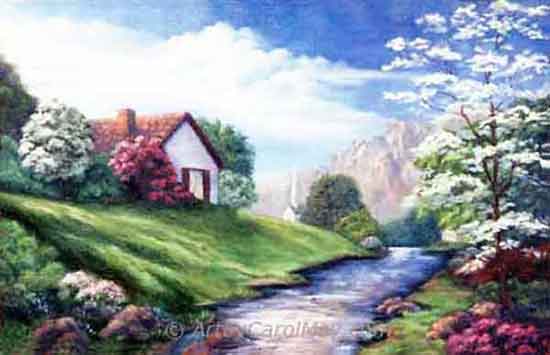 Enter the awesome world of painting art!
Enter the awesome world of painting art!How to Paint Art for Beginners: A Simple Path and Quick Start Projects
If you’re brand new: skim Sections 1–3, then choose one beginner tutorial from Section 4 and paint along.
If you have some experience: feel free to jump straight to the tutorials in Section #4. Use the other sections as a reference whenever you need them.
1. Why and What We Paint
It's no secret why artists paint. We paint to share things we see, what's important to us, express our emotions, or even document history.
Finding ideas and inspiration is a fun part of learning how to paint.
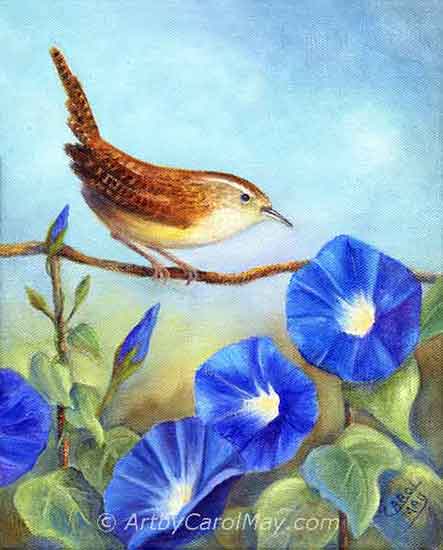 Keep a watch for things to paint.
Keep a watch for things to paint.Everyday life is full of inspiring ideas for a painting. The wonders of nature hold endless paintings.
It may be the bird perched on the backyard fence. We may find interesting things to paint on vacation.
It could be the dog curled up in front of the fireplace or the precious face of a child.
Start a file of ideas.
Keep your eyes open for inspiration. Look at paintings in books, on-line or at art shows.
If you don't have time to sketch things, take some photos that will jog your memory later.
2. What Painting Materials Do You Need?
Quality materials make painting enjoyable and affect the outcome of our paintings.
What are the necessary supplies we need to learn how to paint? Basically, we need: a small set of paints, a couple of brushes, a simple palette, and something to paint on.
Open the sections below to see what I recommend for beginners and why.
What Type of Paint Should We Use?
You may actually try different types of paint to decide which one you prefer.
The most popular types of paint are oil, watercolor and acrylic. Any of these three paints are great for learning to paint art.
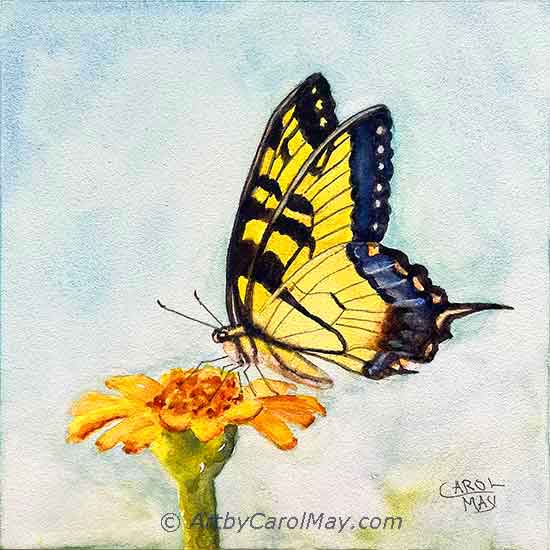 Painting watercolor is easy to learn.
Painting watercolor is easy to learn.Oils dry slower, allowing the artist time to blend and rework the passages before it dries.
Watercolor is often used for delicate, intricate works. Once their techniques are learned they make wonderful paintings.
Acrylic paint is fast drying and relatively inexpensive. It can be painted on various surfaces. One of my art friends does little landscape scenes on rocks and she sells almost every rock.
Visit an extensive explanation of the 3 popular paint mediums.
What Colors Should We Get?
What Colors Should We Get?
Learn to paint with the 3 primary colors.
- Cadmium Light Yellow
- Cadmium Red
- Ultramarine Blue
Other colors are easy to mix from these colors. Practice mixing the primary colors.
Get comfortable mixing and using the primary colors before buying other colors.
What Supplies Do We Really Need?
What Supplies Do We Really Need?
You don’t need a big studio or a huge collection of art supplies to start painting. A small, simple kit is enough to learn the basics and complete your first paintings.
If you’re on a budget, see the Can We Begin Painting on a Budget? checklist on my How to Get into Painting page for a detailed shopping list.
Here, we’ll look at the basic items you need and how to think about them as you learn.
Paint: For most beginners, the primary colors plus white are enough to mix a wide range of colors.
- Three primaries (a yellow, a red, and a blue)
- A tube of white (for oil, alkyd, and acrylic)
Later, you can add extra colors.
Brushes: In
the beginning, you can learn a lot with just one or two brushes per medium. I
did:
- Oils/alkyds: A couple of flat brushes in a medium and larger size
- Watercolor: A good round brush and a flat wash brush
- Acrylic: "synthetic brushes" in similar shapes (Not natural hair, they absorb too much water.)
The exact sizes are not as important as getting to know how a few reliable brushes feel in your hand. As you paint, you’ll discover which shapes you naturally prefer.
Palette and Clean-up: There is no need to spend money on an expensive palette in the beginning. You can mix your colors on a plastic or Styrofoam plate.
All artists need rags or paper towels for clean-up.
Gamsol odorless mineral spirits is used with oils. Keep it in a covered container. Watercolor and acrylic artists need a container of water.
You can upgrade to a larger palette or studio tools later, but don’t let that delay your first paintings.
What Do We Paint On?
What Do We Paint On?
Most watercolor artists start on 140 lb. watercolor paper.
Later you may try aquaboard or canvas made especially for watercolor. Originally, I painted watercolor on paper, then I switched. Why did I change to 'Aquabord'.
Oil and acrylic are traditionally painted on canvas.
- Stretched cotton canvas is convenient and ready to paint on.
- Canvas boards are less expensive and great for practice and learning. (They may warp over time.) You may also use a tablet of canvas paper.
- Hardboard panels have a smooth surface that’s wonderful for detail and special pieces you plan to keep or gift.
The surface we paint on is called a "support". What are more art terms we can learn?
As you paint more, you’ll find the materials you like the most and what suits the type of artwork you like to create.
How Do We Clean the Brushes?
How Do We Clean the Brushes?
Watercolor and acrylic brushes clean-up with water.
Swish the brushes in a container of water. Acrylic may require some mild soap the get all the paint out.
Be sure and clean your brushes before the paint dries in the brush!
Oil paint is cleaned up with odorless mineral spirits. Gamsol is the one recommended for studio painting.
Lay the cleaned brushes flat, horizontally to dry.
Don't put them upright to dry, stuff will run down into the ferrule and eventually ruin the brushes.
What Do I Need in My Painting Space?
What Do I Need in My Painting Space?
Good light and ventilation are a must for painting with all mediums.
Get ideas on where to paint and setting up your home art studio.
3. Fundamentals of Painting Art
When we’re learning how to paint, we all have questions.
Some common concerns are about composition, color theory, mixing colors, and how to avoid mistakes that can weaken a painting.
What Is Composition and Why Is It Important?
Composition is the way things are arranged in a painting.
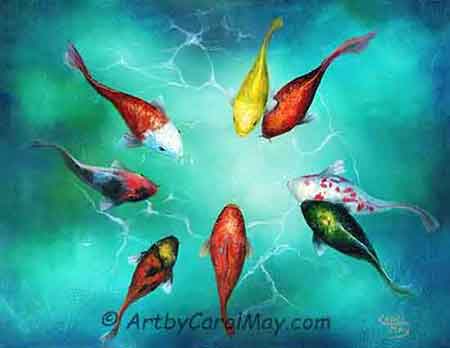 An intriguing composition of Koi
An intriguing composition of KoiA good composition:
- Invites the viewers into the painting.
- Allows their gaze to move around the painting.
- Avoids any blocks or hindrances that stop the eye.
Artists use the rule of center lines and the rule of thirds to create pleasing arrangements.
We want to avoid mistakes with lines, shapes, tangents, positioning and grouping items.
Get my tips for creating strong, beginner-friendly compositions.
How Do We Avoid Mistakes? Start by Seeing Values
We all make mistakes (myself included). It’s part of learning. The key is to learn from them so we don’t keep repeating the same ones.
One of the biggest early challenges is paying attention to values - the lightness or darkness of your colors.
It’s easy to fall in love with color (I do!) and forget about values. But even the most beautiful colors will look flat if they’re all in the middle value range.
Your paintings become much more powerful when you use a good mix of light, medium, and dark values.
The colorful painting below has many medium values, but there is good contrast between the light and dark values.
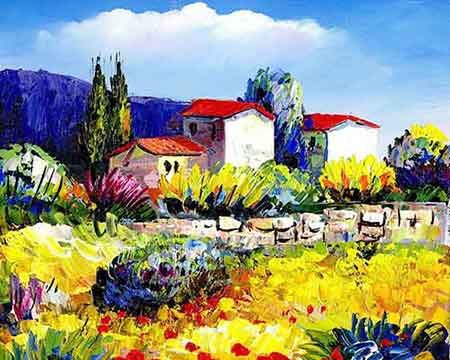 Colors are awesome!
Colors are awesome!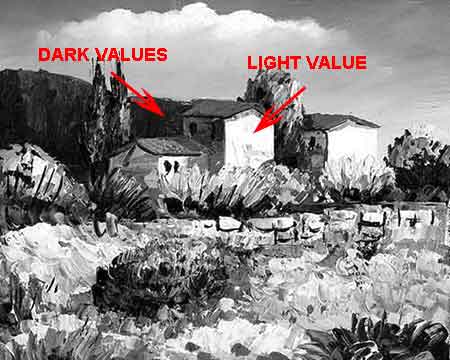 Values are the backbone of paintings.
Values are the backbone of paintings.You’ll see a big difference when you use a good range of light, medium, and dark values in your work.
Learn more about seeing and using values in your paintings.
Try this:
Before your next painting, do a tiny value study with just 3 values; light, medium, and dark. Then use that as a guide when you paint in color.
Quick Start - Practice Seeing Values
- Select 2-3 paintings you admire, at work, online, in a book or magazines.
- Snap a photo of each one with your phone and convert the photos to grayscale (black and white).
- Look for the lights and darks. Where are the lightest areas? The darkest?
- Now do the same with 2-3 paintings that feel “unimpressive” to you. Compare the grayscale versions. Do they have less contrast in values?
Notice how much the contrast in values affects the impact of the painting. That's why values are called the “backbone” of a painting.
Do I Use Color Theory to Mix Colors?
Yes, definitely.
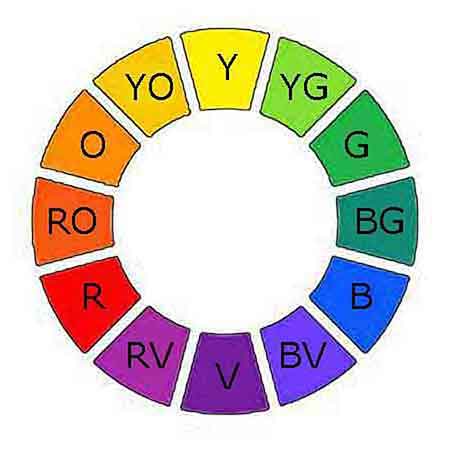 Artists use the color wheel often.
Artists use the color wheel often.
We learn color theory from the artist’s color wheel. It teaches:
- Primary colors
- Secondary and tertiary colors
- We learn how colors relate to each other (warm and cool colors, complementary pairs, etc.)
Over time, many artists memorize the color wheel and use it almost automatically.
Visit the artist color wheel page to learn more color theory.
Quick Start - Warm and Cool Colors
1. Look at the color wheel image above (or your own color wheel).
2. Make a list of the warm colors you see.
3. Make a list of the cool colors you see.
HINT: Warm colors contain yellow. Cool colors normally contain blue.
How Do We Learn to Mix Colors?
Beginning artists should start with the three primary colors; red, yellow and blue.
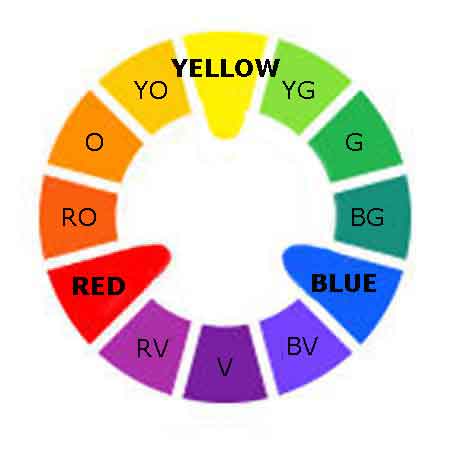 Mix colors from the 3 primaries.
Mix colors from the 3 primaries.- We know mixing red and yellow creates orange.
- Yellow and blue make green.
- Blue and red make a violet (purple).
Mix oil, alkyd or acrylic with a palette knife. Watercolor is mixed with a brush.
Use small dabs of paint and slowly add bits of the darker color to the lighter color until you get the desired color.
It doesn't take much dark color to change a lighter color.
Quick Start - Mix Your Own Colors
1. Put a small amount of each primary color (red, yellow, blue) on your palette.
2. Mix the secondary colors:
- Red + yellow = orange
- Yellow + blue = green
- Blue + red = violet
3. Bonus: How to Mix Tertiary Colors
- Yellow + orange = yellow-orange; red + orange = red-orange
- Yellow + green = yellow-green; blue + green = blue-green
- Blue + violet = blue-violet; red + violet = red-violet
Great job! You have mixed 6 new colors that you don't have to buy.
How Do I Choose the Right Colors for My Paintings?
Each of the painting tutorials have a list of the colors used in that particular painting.
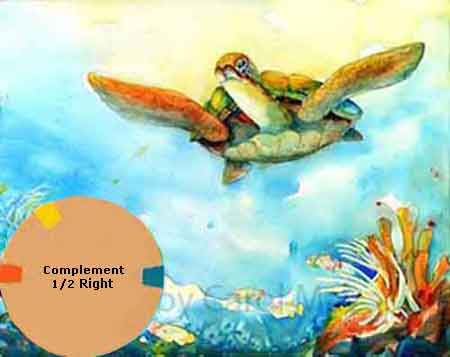 This painting only used 3 colors.
This painting only used 3 colors.For your own paintings, lean toward a limited palette with the least number of colors possible. This makes color harmony easier.
A simple way to choose your colors:
- Decide on the main color for your focal subject. It may be a warm or cool color.
- Choose a color that's the opposite of the subject's color. For example, if the subject color is warm, choose a cool color or vice versa.
- Add a third color that complements or highlights the first two colors.
Get the details on how I chose the colors of the turtle painting.
Quick Start – Plan a Simple Palette
1. Pick a subject you want to paint (for example, a turtle, a flower, or a cup of coffee).
2. Choose one main color for your subject.
3. Choose its opposite on the color wheel for your shadows and darks.
4. Add one extra color for small accents or highlights.
4. Learn How to Paint with the Tutorials
The best way to learn painting is by actually doing it! The tutorials are great for practice and learning how to paint at the same time.
Choose the tutorials that pique your interest and start painting. You may be drawn to the fluidity of watercolor or the rich textures of oil paint.
Oil Painting Tutorials
Please Note: The oil tutorials may also be used for acrylic or alkyd paint.
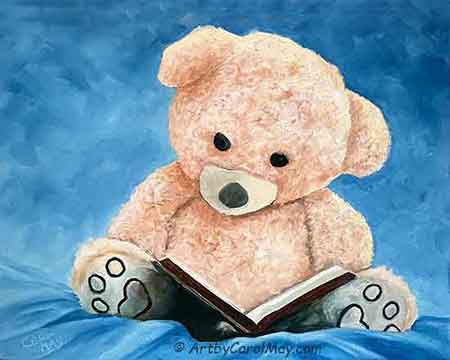 Learn and paint with the oil painting rules.
Learn and paint with the oil painting rules.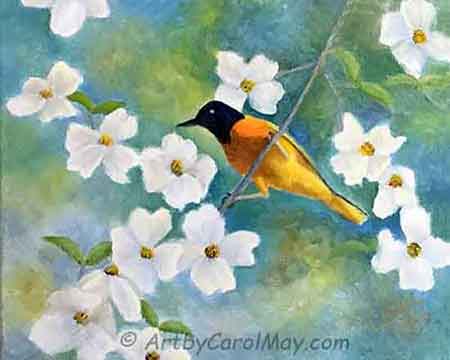 Begin painting oils with a colorful bird.
Begin painting oils with a colorful bird.Now try this: Choose one beginning oil tutorial from above and set a time this week to paint it.
Ready to choose your next project? Browse all my step-by-step painting tutorials.
How to Paint Watercolor Tutorials
The best way to learn how to paint is by actually painting.
Start here: Pick one beginner watercolor tutorial from above and set a time to paint it.
5. How to Stay Inspired and Find Your Style
We stay inspired by painting often. Many professional artists paint daily, but even short, regular sessions will keep you moving forward.
- Join your local art association and paint with other artists.
- Go to art shows, and visit art museums.
- Share your paintings with friends, family, and other artists.
- Try painting different subjects, using new colors, or a different medium for a while. I often switch back and forth between oils and watercolor.
- Notice what you enjoy most and explore it. It may become your new style.
How Do I Find My Own Unique Style?
Experimenting with different painting styles is part of finding our personal artistic voice.
Realism depicts subjects as they are in real life. It takes sharp observation, technical skills a lot of time and patience. It's a challenge, but it can be very rewarding.
Abstract art works with shapes, colors,
and forms, that may or may not represent real-life subjects. It conveys emotions and
ideas rather than discernible objects.
Impressionism emphasizes light and color, instead of realistic details. The impressionist often uses bold brushwork to create vibrant and dynamic paintings.
Trying different styles expands our horizons and we can discover new ways to express ourselves.
Our artwork may not be a specific style, but it will be uniquely ours.
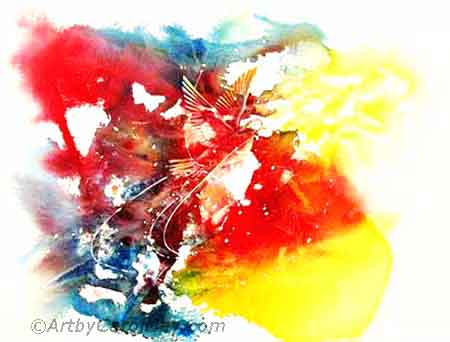 Don't hesitate to experiment.
Don't hesitate to experiment.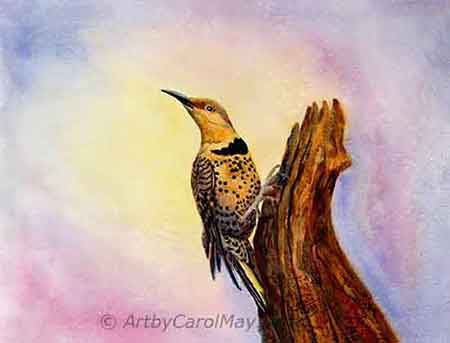 Realism requires patience.
Realism requires patience.Frequently Asked Questions
We’ve covered what to paint, your materials, fundamentals, and tutorials. Here are some final quick answers to common questions beginners ask:
Can I learn to paint if I can’t draw?
- Yes, you certainly can. Start by looking at things as simple shapes - a triangle for a Christmas tree, a square for a sandwich, or a circle for a ball.
- When we get the shapes right, our subject automatically starts to look like what it is. As you paint, you’ll gradually pick up more drawing skills, so don’t wait to be “good at drawing” before you start painting.
- If drawing is holding you back, visit my How to Get into Painting page for a simple trick to start you painting right away.
How long does it take to learn how to paint?
- There’s no single answer. How fast you learn depends mostly on how much and how often you paint. For example, one person might paint once a month for 6 hours, while someone else paints four times a month for 1½ hours.
- The more frequent painter usually improves faster, because skills grow with regular practice, not just long sessions.
Is oil painting harder than watercolor for beginners?
- I don’t think oils are harder (I’m a bit biased, because I learned with oils!). Oils dry more slowly, which gives you extra time to blend and adjust. Watercolor is beautiful but less forgiving, because it dries faster making adjustments harder.
- You can learn to paint in any medium with a good teacher and some patience - choose the one that excites you most.
How often should I practice painting as a beginner?
- Daily painting puts our learning into warp drive!
- Many of us can’t paint every day. But painting once a week is a fast track to steadily becoming a confident, proficient artist.
- The key is to paint as often as your schedule allows, and keep coming back to it.
You Can Learn How to Paint
Let your creativity flow!
As you explore the different techniques and subjects, focus on the joy of creating and allow each painting to teach you something new.
Don’t hesitate to experiment, express yourself and find your style. That's the joy of painting art.
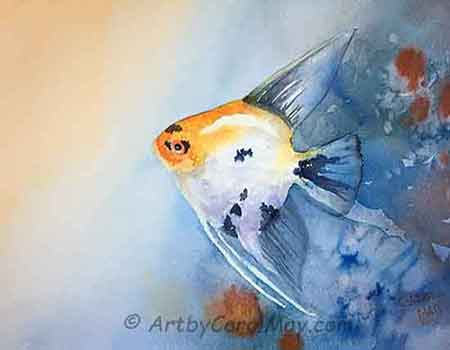
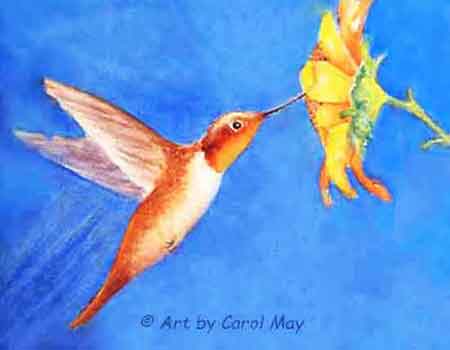







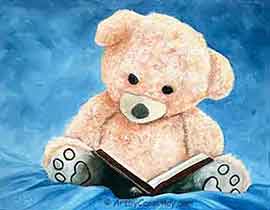 Are you eager to learn how to oil paint? What are the essential supplies for oil painting? What do we need for clean-up and how long do oil paintings take to dry? Learn the rules of oil painting and t…
Are you eager to learn how to oil paint? What are the essential supplies for oil painting? What do we need for clean-up and how long do oil paintings take to dry? Learn the rules of oil painting and t…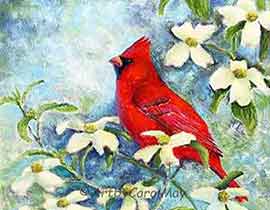 How do we create a focal point in art? Where do we put the focal point? How do we find the focus of an artwork? Should all paintings have a center of interest or can they have more than one? Learn fro…
How do we create a focal point in art? Where do we put the focal point? How do we find the focus of an artwork? Should all paintings have a center of interest or can they have more than one? Learn fro…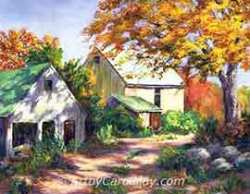 Art elements and principles appear over and over in good paintings. The elements and principles work together for us to create successful artwork. Art principles are the rules that govern how an artis…
Art elements and principles appear over and over in good paintings. The elements and principles work together for us to create successful artwork. Art principles are the rules that govern how an artis…